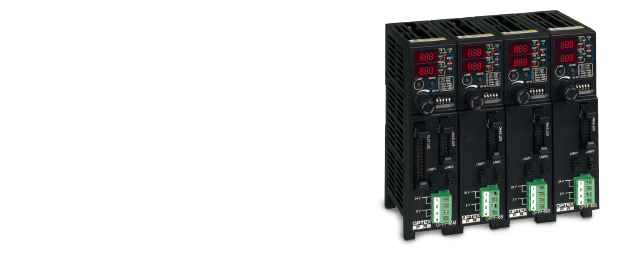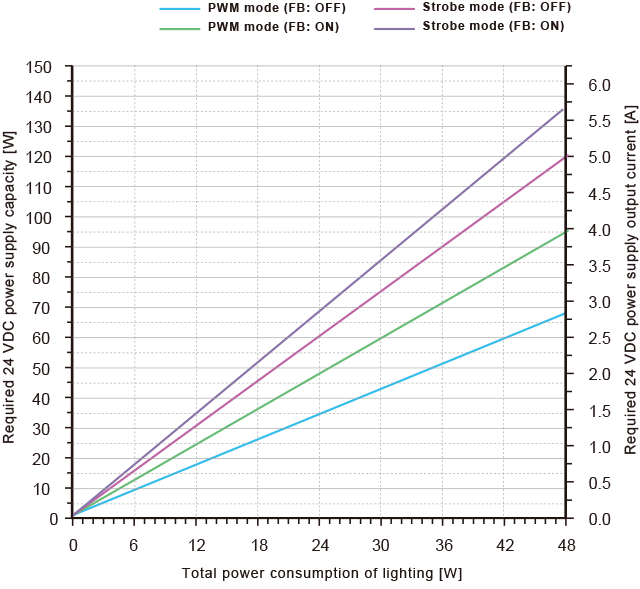LED Lighting Controller AdvancedOPPF Series
Increased capacity with up to 48 W in PWM mode and up to 24 W in strobe mode
- “FALUX sensing” for monitoring brightness and temperature monitoring and for controlling feedback
- Support for RS232, parallel, and 0 to 5 V analog input for external dimming control

Lineup
| Type | Model | Type | Weight [g] | Illumination Output | Capacity |
|---|---|---|---|---|---|
|
Standard type |
OPPF-48MN | Master device NPN output | 385 | 2ch |
Max. 30 W per channel Max. 48 W for 2 channels (total) See table 1 Max. 24 W per channel Max. 48 W for 2 channels (total) |
| OPPF-48MP | Master device PNP output | ||||
| OPPF-48SN | Slave device NPN output | 375 | |||
| OPPF-48SP | Slave device PNP output | ||||
|
Illumination control input TTL type |
OPPF-48MN-TTL | Master device NPN output | 385 | ||
| OPPF-48MP-TTL | Master device PNP output | ||||
| OPPF-48SN-TTL | Slave device NPN output | 375 | |||
| OPPF-48SP-TTL | Slave device PNP output |
*When using NPN or PNP output for error output or illumination output, select the output according to the input device. NPN/PNP is common for lighting output and lighting/dimming control input.
Table1 OPPF-48 <PWM mode> Max. lighting combination examples *Max 30 W/ch
| Lighting 1 | Lighting | Total | ||
|---|---|---|---|---|
| 24 W | + | 24 W | → | 48 W |
| 25 W | + | 20 W | → | 45 W |
| 26 W | + | 16 W | → | 42 W |
| 27 W | + | 12 W | → | 39 W |
| 28 W | + | 8 W | → | 36 W |
| 29 W | + | 4 W | → | 33 W |
| 30 W | + | 0 W | → | 30 W |
Specifications
| Model | OPPF-48MN | OPPF-48MP | OPPF-48SN | OPPF-48SP |
|---|---|---|---|---|
| Type | Master device NPN output | Master device PNP output | Slave device NPN output | Slave device PNP output |
| Power supply voltage | 24 VDC ±10% | |||
| Current consumption |
PWM mode ― Feedback OFF: Max. 2.9 A, Feedback ON: Max. 4.0 A Strobe mode ― Feedback OFF: Max. 5.0 A, Feedback ON: Max. 5.7 A |
|||
| Illumination output | 2 channels | |||
| Connectable lighting | PWM mode: Max. 48 W (2 ch total) *Max 30 W/ch, Strobe mode: Max. 24 W (per channel) | |||
| Illumination output voltage | PWM mode: 12 VDC (standard), Strobe mode: 18 VDC (standard) | |||
| Illumination output current | PWM mode: Max. 4.0 A (2 ch total), Strobe mode: 8.0 A (per channel) | |||
| Dimming method |
PWM dimming, Frequency: 20/50/100/99/98/97 kHz 1,000 steps *Common for PWM mode and strobe mode |
|||
| Strobe |
Luminescence width: 10 μs to 9.99 ms (10 μs steps) or 1 ms to 999 ms (1 ms steps) *12 VDC driving when exceeding 1 ms Flash cycle limit at 18 VDC: 10% Duty (10 times or more the pulse width cycle required) |
|||
| Monitoring |
Lighting brightness monitor / Lighting internal temperature monitor, Monitor brightness alarm lower limit value setting Update cycle per communication between lighting and power supply, Received light amount: 21 ms, Temperature: 105 ms |
|||
| Feedback |
Voltage variable method ― PWM mode: 11 to 18 VDC Strobe mode: 16 to 22 VDC, Accuracy: ±1.5% or less (typ.) *This specification is for reference only and is not a guarantee of the performance of this product. |
|||
| Input |
External illumination control × 2, Analog dimming select × 1, Parallel dimming input × 10 (bank select × 4 shared), Parallel dimming writing input × 1, Channel select input × 3 |
External illumination control × 2, Analog dimming select × 1 |
||
|
ON voltage: 5 V or more, OFF voltage: 1.2 V or less, Max. input voltage: 30 V Illumination control input response time (actual value) With 24 V input (OFF→ON: 5 μs, ON→OFF: 60 μs), With 5 V input(OFF→ON: 44 μs, ON→OFF: 41 μs) Input resistance: 6.8 kΩ, insulated; Other input response time: 1.1 to 14.8 ms |
||||
| Analog input | 0 to 5 V, Input resistance: 220 kΩ, Non-insulated | |||
| Output |
Lighting overcurrent error output × 1, Feedback warning output × 2, Lighting illumination output × 2 Open collector, Max. 100 mA / 30 VDC, Residual voltage 1.0 V max. |
|||
|
Lighting overcurrent / internal temperature abnormal / feedback error output × 1 Open collector, Max. 100 mA / 30 VDC, Residual voltage 1.5 V max. |
- | |||
|
Communication interface |
RS232: 1 ch, Baud rate: 4,800/9,600/ 19,200/38,400/57,600/115,200 |
- | ||
|
Master―slave communication |
Infrared communication method ― RS232 from master device to slave device, External input control (dimming, bank selection), Transmission from slave device to master device (error information, RS232 reading), Setting copy function Communication cycle: Approx. 15 ms (equivalent response time for controlling slave device with RS232, external input) |
|||
|
Lighting output protection circuit |
Overcurrent | |||
|
Signal output protection circuit |
Overcurrent | |||
|
Other protective functions |
Power supply internal temperature monitoring (PWM output cut to 1/4 at 105°C) Lighting internal temperature monitoring, Lighting brightness lower limit alarm |
|||
|
Ambient temperature/ humidity |
0 to 45°C / 35 to 85% RH (no condensation) | |||
|
Storage temperature/ humidity |
-20 to 70°C / 35 to 95% RH (no condensation) | |||
| Vibration resistance | 10 to 55 Hz; amplitude 1.5 mm; 2 hours in each of the X, Y, and Z directions | |||
| Shock resistance | Approximately 10 G, 3 times in each of the X, Y, and Z directions | |||
| Insulation resistance | 500 VDC, 10 MΩ or more | |||
| Material | Polycarbonate | |||
| Weight | 385 g | 375 g | ||
| Protection rating | IP20 (IEC 60529: 1989 / A1: 1999 + A2: 2013) | |||
| Applicable regulations | EMC (2014/30/EU) / RoHS (2011/65/EU, MIIT Order No.32) | |||
| Applicable standards |
EN 61000-6-2: 2005 / AC: 2005, EN 55011: 2009 / A1: 2010 (EN 55011 testing was performed with the lighting cable passed through shielded tubing grounded to FG.) |
|||
| Accessories | Terminal block × 1 | |||
| Model | OPPF-48MN-TTL | OPPF-48MP-TTL | OPPF-48SN-TTL | OPPF-48SP-TTL |
|---|---|---|---|---|
| Type | Master device NPN output | Master device PNP output | Slave device NPN output | Slave device PNP output |
| Input |
Illumination control input (TTL) |
ON voltage: 2 V or more, OFF voltage: 0.9 V or less Max. input voltage: 16 V, Input resistance: 1 kΩ, Insulated |
||
|
Response time (actual value) ― 5 V: 5 μs (OFF → ON) / 75 μs (ON → OFF) 3 V: 8 μs (OFF → ON) / 70 μs (ON → OFF) 2 V: 20 μs (OFF → ON) / 60 μs (ON → OFF) |
||||
| Other inputs | ON voltage: 5 V or more, OFF voltage: 1.2 V or less, Max. input voltage: 30 V | |||
|
Input resistance: 6.8 kΩ, insulated; Response time (actual value): 1.1 to 14.8 ms |
||||
Required 24 VDC power supply capacity to handle power consumption of lighting
-
Based on the total power consumption of the LED lighting to be connected, select a 24 VDC power source that offers more than the required capacity.
Note: When using in conjunction with other equipment, the characteristics of the other equipment will affect the power supply, so be sure to choose a power supply that has a sufficient margin (about twice as much) as that shown in the table.
*Evaluation power source: IDEC PS5R-SF24 (120 W), PS5R-SG24 (240 W)
-




